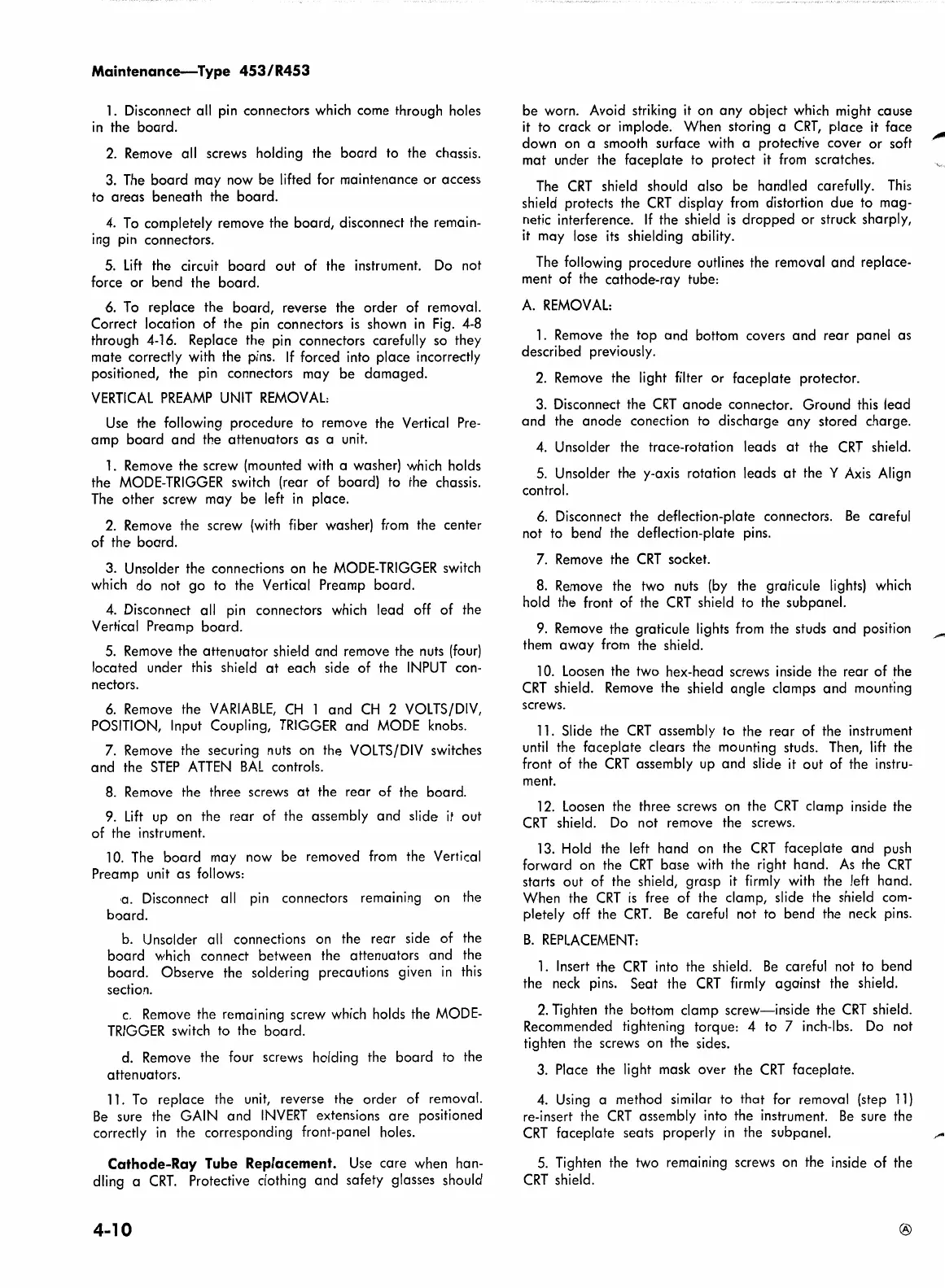Maintenance-Type
453/R453
l.
Disconnect all
pin
connectors which come through holes
in
the board.
2.
Remove
all screws holding the board
to
the chassis.
3.
The
board may
now
be lifted
for
maintenance or access
to areas beneath the board.
4.
To
completely remove the board, disconnect the remain-
ing
pin
connectors.
5.
Lift
the circuit board out of the instrument.
Do
not
force or bend the board.
6.
To
replace the board, reverse the order of removal.
Correct location of the
pin
connectors
is
shown
in
Fig.
4-8
through
4-16.
Replace the
pin
connectors carefully
so
they
mate correctly with the
pins.
If forced into place incorredly
positioned, the
pin
connectors may be damaged.
VERTICAL
PREAMP
UNIT
REMOVAL:
Use
the following procedure to remove the Vertical
Pre-
amp board and the attenuators as a
unit.
1.
Remove
the screw (mounted
with
a washer) which holds
the
MODE-TRIGGER
switch (rear of board)
to
the chassis.
The
other screw may be left
in
place.
2.
Remove
the screw
(with
fiber washer)
from
the center
of the board.
3.
Unsolder the connections on
he
MODE-TRIGGER
switch
which do not go
to
the Vertical Preamp board.
4.
Disconnect all
pin
connectors which lead off of the
Vertical Preamp board.
5.
Remove
the attenuator shield and remove the
nuts
(four)
located under
this
shield
at
each side of the
INPUT
con-
nectors.
6.
Remove
the
VARIABLE,
CH
1 and
CH
2
VOL
TS/DIV,
POSITION, Input Coupling,
TRIGGER
and
MODE
knobs.
7.
Remove
the
se·curing
nuts
on
the
VOLTS/DIV
switches
and the
STEP
A
TTEN
BAL
controls.
8.
Remove
the three screws
at
the rear of the board.
9.
Lift
up
on
the rear of the assembly and slide
it
out
of the instrument.
10.
The
board may
now
be removed
from
the Vertical
Preamp unit as follows:
'a.
Disconnect all
pin
connectors remaining on the
board.
b.
Unsolder all connections
on
the rear side of the
board which connect between the attenuators and the
board. Observe the soldering precautions given
in
this
section.
c.
Remove
the remaining screw
which
holds the
MODE-
TRIGGER
switch
to
the board.
d.
Remove
the four screws holding the board
to
the
attenuators.
11.
To
replace the
unit,
reverse the order of removal.
Be
sure the GAIN and
INVERT
extensions are positioned
correctly
in
the corresponding front-panel holes.
Cathode-Ray
Tube
Replacement.
Use
care when han-
dling a
CRT.
Protective clothing and safety glasses should
4-10
be worn. Avoid striking
it
on any object which might cause
it
to crack or implode. When storing a
CRT,
place
it
face
down on a smooth surface
with
a protective cover or soft
mat under the faceplate
to
protect
it
from
scratches.
The
CRT
shield should also be handled carefully.
This
shield protects the
CRT
display
from
distortion due
to
mag-
netic interference. If the shield
is
dropped or struck sharply,
it
may lose
its
shielding ability.
The
following procedure outlines the removal and replace-
ment of the cathode-ray tube:
A.
REMOVAL:
1.
Remove
the top and bottom covers and rear panel as
described previously.
2.
Remove
the light filter or faceplate protector.
3.
Disconnect the
CRT
anode connector. Ground
this
lead
and the anode conection to discharge any stored charge.
4.
Unsolder the trace-rotation leads
at
the
CRT
shield.
5.
Unsolder the y-axis rotation leads
at
the Y
Axis
Align
control.
6.
Disconnect the deflection-plate connectors.
Be
careful
not
to
bend the deflection-plate
pins.
7.
Remove
the
CRT
socket.
8.
Remove
the two
nuts
(by
the graticule
lights)
which
hold the front of the
CRT
shield to the subpanel.
9.
Remove
the graticule lights
from
the studs and position
them away
from
the shield.
10.
Loosen
the two hex-head screws inside the rear of the
CRT
shield.
Remove
the shield angle clamps and mounting
screws.
11.
Slide the
CRT
assembly
to
the rear of the instrument
until
the faceplate clears the mounting studs.
Then,
lift
the
front of the
CRT
assembly
up
and slide
it
out of the instru-
ment.
12.
Loosen
the three screws
on
the
CRT
clamp inside the
CRT
shield.
Do
not remove the screws.
13.
Hold
the left hand on the
CRT
faceplate and
push
forward on the
CRT
base
with
the right hand.
As
the
CRT
starts out of the
shie·ld,
grasp
it
firmly
with
the left hand.
When the
CRT
is
free of the clamp, slide the shield
com-
pletely off the
CRT.
Be
careful not to bend the neck
pins.
B.
REPLACEMENT:
1.
Insert the
CRT
into the shield.
Be
careful not
to
bend
the
neck
pins.
Seat the
CRT
firmly
against the shield.
2.
Tighten the bottom clamp
screw-inside
the
CRT
shield.
Recommended tightening torque: 4
to
7 inch-lbs.
Do
not
tighte·n
the screws on the sides.
3.
Place the light
mask
over the
CRT
faceplate.
4.
Using
a method similar
to
that for removal (step
11)
re-insert the
CRT
assembly into the instrument.
Be
sure the
CRT
faceplate seats properly
in
the subpanel.
,,,..
5.
Tighten the two remaining screws
on
the inside of the
CRT
shield.
®

